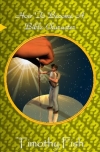
And Thy House
Extra Feature: High Res Image

History of
Cane Creek
Association
by D. F. Magruder
Applying Photographic Principles to Writing
Written By: Timothy Fish Published: 3/4/2008
Writing and photography have some many similarities. They are both art. Anyone can do either one, but it takes skill to do them well. Point of View is important in both. So, what happens if we apply principles of photography to writing? Let’s look at some concepts in photography that apply to writing, simplicity, the rule of thirds, lines, balance, framing and mergers.
Simplicity
In photography, we want to keep it simple. Suppose we take a picture and end up with a tree, a bus and a courthouse in the picture. Which object is important? Or suppose we take a picture and have a busy background? Rather than our eye being drawn to the object of importance, it is distracted by everything else that is going on. The way to improve this is to find a way to produce a simple background, such as a blue sky and zoom in close enough that the object of interest is the prominent feature of the photo. Focus on the beauty that drew you to the scene in the first place and use the camera to remove everything else.
In writing, having too much stuff going on can take away from the scene. Suppose a scene takes place in the middle of a battle. There may be hundreds or thousands of men fighting on the battlefield, with thousands of different stories. That can be distracting. To help the scene, we focus more tightly on two combatants who are engaged in a fight. Every fight has two and only two primary combatants. If we focus on them tightly enough, the rest is unimportant.
The Rule of Thirds
The rule of thirds says that a photograph tends to be more interesting if the primary point of interest is off center. By changing the view point of the a scene, an image that was uninteresting can suddenly become interesting.
Many novels, particularly romance novels, are written from the point of view of one of the primary characters. The narrator sweeps in so close that he can hear the lead character’s thoughts. He can feel her pain as she longs for Mr. Right to ask her to marry him. This viewpoint is very much a centered viewpoint. The most important character is right in the middle. There is nothing wrong with that, but what if we apply the rule of thirds and move the main primary character off to the side and up or down a little? To do that, instead of telling the story from the point of view of the female lead, we tell the story from the point of view of her daughter, best friend or mother. It adds depth to the story and makes it more interesting because the reader keeps looking for more information about who that eccentric person on the hill really is.
Lines
Lines in a photo draw the eye toward or away from a point of interest. Look at a photo of railroad tracks and where does your eye naturally look? It will follow the track to the end. You might go back and look at other things, but your natural inclination is to follow the track. Lines help to connect one point of interest to another. Repeating lines can help to place more importance on a central subject.
In a novel, think of a line as being some type of action that takes place. A character does something and though it may seem unimportant by itself, it helps to draw the reader’s attention to something more important. A minor character might state the theme of the book early on. The book might be about a woman who must learn to trust other people. A minor character might say something about trust early in the book. It seems unimportant at the time, but it helps to draw the reader’s attention to the theme. The theme might be repeated later, creating another line, once more drawing the reader’s attention to the theme.
Balance
When an image gives you the feeling that you are waiting for the other shoe to drop, it may be an issue of balance. Balance deals with composing an image in such a way that it doesn’t look lopsided.
A well balanced story is one in which the protagonist and the antagonist are equals. Superman would be very uninteresting if he never fought anyone except kids stealing candy. Cinderella would be uninteresting if her step-mother had encouraged her to go to the ball. It is the balance between protagonist and antagonist that makes us wonder which way the scale will tip in the end.
Framing
Framing can add interest to a photo by adding depth to the point of interest. The frame can be anything from flowers and trees in the foreground to a window or even people. Framing can help to show the importance of the object of interest.
Framing in writing can take the form of foreshadowing and reminders about what has happened. Rather than dropping the reader into a scene and saying “something bad happened,” the writer can frame the scene by indicating that something bad might happen and help the reader to understand just how bad it would be if that something happened. After the scene, the writer can continue to show how bad it was that this particular thing happened.
As an example, without a frame we might say, “the cat died.” With a frame we might say, “That is Joe’s favorite cat. The cat died. Joe is sad because the cat died.” The point being that if you don’t know you are supposed to care that the cat died then you won’t.
Mergers
When a tree appear to be growing out of someone’s head, when the border of the photo cuts through an object of interest or two objects of similar color seem to blend together it is merger. The problem with these things is that it draws the attention away from what is important toward something that may look a little silly.
In novels, we have a similar situation when the B-story or the C, D or E story starts to overshadow the A-story. This seems to be an accepted practice for romance novels, but in most other novels the A-story takes precedence over everything else. Suppose the A-story is about catching a killer and the B-story is about the detective raising his family. If the author focuses too much on the detective’s family life then the B-story may preempt the story about catching the killer. When the book draws to a close and the killer is revealed, the reader may think, “O yeah, there was a murder that took place.”
The solution for writers is to stay focused on the A-story. If the B-story is so compelling that it is overpowering the A-story, then maybe it should become the A-story.
Last Thoughts
A story is like a photo in many ways. Some of the best storytellers are people who tell stories through pictures and movies. Writers must use words to describe the picture in their mind. Moving the camera and developing a better looking mental image, a writer can produce a better image for the reader.
www.timothyfish.com



